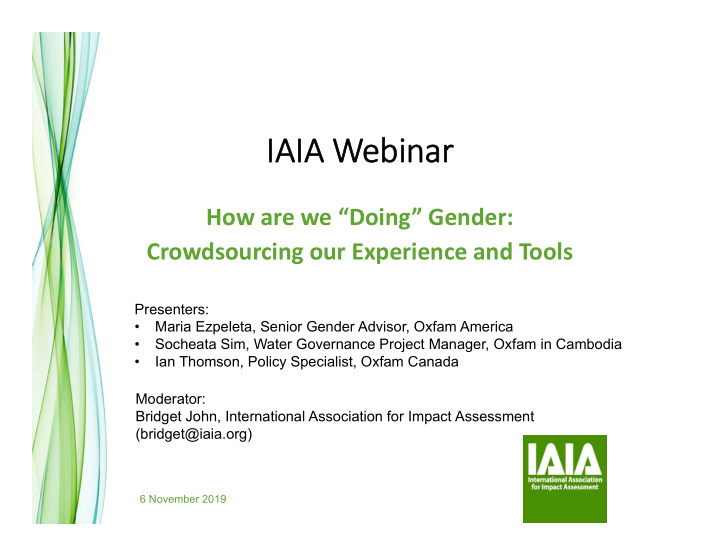



IAIA Webinar How are we “Doing” Gender: Crowdsourcing our Experience and Tools Presenters: • Maria Ezpeleta, Senior Gender Advisor, Oxfam America • Socheata Sim, Water Governance Project Manager, Oxfam in Cambodia • Ian Thomson, Policy Specialist, Oxfam Canada Moderator: Bridget John, International Association for Impact Assessment (bridget@iaia.org) 6 November 2019
IAIA’s Webinar Series • A Rapid Tour of Emerging Technologies and IA • Accessing and Interpreting Biodiversity Information for High‐ level Biodiversity Screening • Empowering Indigenous Voices in Impact Assessment • Understanding Impacts on Vulnerable Populations through Psycho‐Social Impact Assessment • Health Considerations in Impact Assessment • Resettlement and Impact Assessment – Points of Intersection • And several more… Visit http://www.iaia.org/webinars.php @IAIAnetwork #iaiawebinar
Housekeeping Recording? Questions? Slides available?
Maria J. Ezpeleta Senior Gender Advisor Oxfam America maria.ezpeleta@oxfam.org
Socheata Sim Water Governance Project Manager Oxfam in Cambodia socheata.sim@oxfam.org
Ian Thomson Policy Specialist Oxfam Canada ian.thomson@oxfam.org
HOW ARE WE ‘DOING’ GENDER: Crowdsourcing our Experience & Tools Oxfam’s Gender Impact Assessment Guide Maria Ezpeleta Ian Thomson 6 November, 2019 Socheata Sim
TODAY’S SESSION Ian Thomson
Learning Objectives • Discuss tools, techniques & approaches for gender impact assessment (GIA), with Oxfam’s guide as one example • Share key opportunities for integrating gender analysis into IA Page 9
What is GIA? Maria Ezpeleta
What is GIA? • Identifies gender- differentiated impacts & opportunities • Process-oriented, transformative potential • Ideally early on • Planning & design tool Page 11
GIA IN PRACTICE Socheata Sim
Mekong Regional Water Gov Program • Pilot GIA in Lao PDR (Thuen Hin Boun Hydro) in partnership with Lao Women Union (LWU) • Pilot GIA in Vietnam – Central Highland (Aluoi, Srepok 3, hydropower area ) in partnership with Center for Social Research and Development (CSRD) • Partnership with: THB Hydro Company, GENCO 1, and 3, Vietnam Electricity Group (EVN), A Vuong company • Capacity training: CSRD staff, local researcher, LWU provincial staff (incl. relevant departments) Page 13
Some Key Findings Participation rate: • Men played larger role in decision-making on compensation and livelihood restoration strategies. • Women sometimes co-signed compensation documents but not always. Hydro-induced impacts: • Women faced greater economic challenges and health impacts (physical and mental) due to gender division of labour and roles. Page 14
OXFAM’S GIA GUIDE Maria Ezpeleta
Why GIA? • Based on gender analysis • Assesses layered forms of vulnerability & impacts • Participatory community engagement • Promotes gender equality Page 16
Oxfam’s GIA Guide https://www.oxfam.org.au/wp- content/uploads/2017/04/2017- PA-001-Gender-impact- assessments-in-mining- report_FA_WEB.pdf Page 17
Four Steps to GIA Step 1: Baseline Principles • Participatory & safe • Most marginalized • Rights-based Step 4: Step 2: • Transparent GIA Review Dialogue • Actionable and and improve analysis Step 3: Planning Page 18
Example: Step 1, Baseline info *Best practice would be to include a third column in the Access and Control profile for gender-diverse or gender-non-conforming groups Page 19
Mobile App… • Baseline data (Step 1) • Gender-disaggregated data • Reports • Hydropower & extractive industries Page 20
BENEFITS & OPPORTUNITIES Socheata Sim
Benefits & Opportunities • Simple steps – can be • Piloted in project area inserted into project after operation. It cycle could be more opportune at an • Opens up space for earlier stage dialogue with company & • Getting private sector government buy-in to use the tool as a good practice Page 22
CROWDSOURCING: LET’S CHAT Ian Thomson
Be a part of the discussion! • Continue to type questions or share experiences through the Questions pane. • To share verbally, raise your hand. Bridget will unmute you and announce your name. (Do not unmute yourself.)
Questions or Comments?
Webinar poll results Bringing Gender into Impact Assessment: 4% Never tried it 11% Find it 37% challenging Had positive 24% experiences Done it more regularly Do it all the 25% time n = 377 registrants Page 26
Webinar poll results Biggest Challenge in Doing Gender Work: Inexperience or lack of gender expertise Challenges in the local context Lack of tools and methods Unclear policy frameworks and standards Other Expectations of client/proponent Expectations of local stakeholders n = 375 registrants Page 27
How about these? • What are some tools, techniques or approaches you are using to integrate gender into your assessment work? • Can anyone share how you overcame challenges, any lessons learned or opportunities created in the process? Page 28
Thank YOU
Resources • Oxfam’s GIA guide for extractive industries: https://www.oxfam.org.au/wp- content/uploads/2017/04/2017-PA-001-Gender-impact-assessments-in- mining-report_FA_WEB.pdf • Oxfam, Balancing the scales: Using gender impact assessment in hydropower development: https://asia.oxfam.org/policy-paper/gender- impact-assessment-gia-manual • Center for Social Research and Development (CSRD): GIA brief in Sreh Pok: https://issuu.com/csrd7/docs/policy_brief_gia_2 • Policy Influence & Outcomes of Mekong Inclusion Project: https://cng- cdn.oxfam.org/asia.oxfam.org/s3fs- public/file_attachments/Policy%20influence%20and%20outcomes%20of%2 0Oxfam%20Mekong%20Inclusion%20Project.pdf • Oxfam Position Paper on Gender Justice and Extractive Industries: https://www.oxfamamerica.org/static/media/files/EI_and_GJ_position_paper _v.15_FINAL_03202017_green_Kenny.pdf Page 30
Resources (cont’d) • Gender & Development (2017): Lessons Learnt from gender impact assessment of hydropower project in Laos and Vietnam: https://www.womenforwater.org/uploads/7/7/5/1/77516286/lessons_learnt_f rom_gender_impact_assessments_of_hydropower_projects_in_laos_and_v ietnam.pdf Page 31
Thank You! ian.thomson@oxfam.org socheata.sim@oxfam.org maria.ezpeleta@oxfam.org bridget@iaia.org
Recommend
More recommend